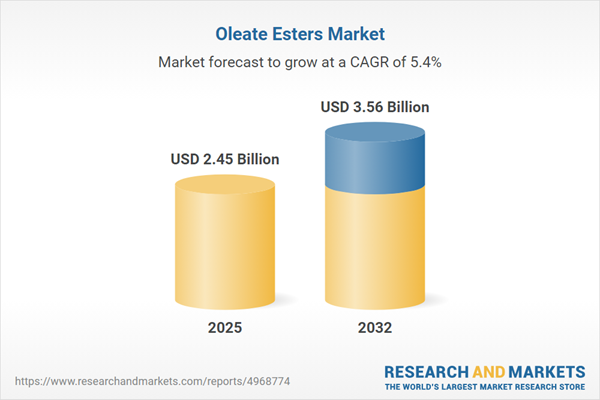Speak directly to the analyst to clarify any post sales queries you may have.
The oleate esters market is progressing as sustainability standards increasingly define industrial practices. Senior decision-makers are capitalizing on oleate esters to support flexible sourcing, strengthen compliance, and drive adaptive product strategies aligned with global environmental goals.
Oleate Esters Market Snapshot
The oleate esters market grew from USD 2.33 billion in 2024 to USD 2.45 billion in 2025, and is expected to sustain a 5.44% CAGR, reaching USD 3.56 billion by 2032. This trajectory is fueled by diverse demand from personal care, pharmaceuticals, lubricants, and food applications. Advancements in production technology, evolving regulations, and dynamic pricing factors continue to shape this sector. Manufacturers are leveraging digitalization, innovative supply chain strategies, and technology integration to bolster the global value chain and support operational resilience.
Scope & Segmentation
This report provides an in-depth view for strategic planning by mapping crucial segments and opportunities across the oleate esters market:
- Application: Food additives, flavoring, nutraceuticals, automotive lubricants, hydraulic fluids, industrial lubricants, cosmetics, hair care, skin care, drug delivery, excipients, flooring, industrial plastics, packaging.
- Product Type: Butyl oleate, ethyl oleate, isopropyl oleate, methyl oleate, oleyl oleate—segments tailored to end-user formulation needs and specific performance attributes.
- Source: Vegetable oil, animal fat, synthetic, microbial fermentation—each source offers variable availability, sustainability impact, and cost considerations, supporting adaptive sourcing.
- Region: Americas, Europe, Middle East & Africa, Asia-Pacific—geographic segmentation that reflects mature infrastructures and rapid regional expansions, adding breadth to supplier diversity and customer reach.
- Key Companies: BASF SE, Croda International Plc, PTT Global Chemical Public Company Limited, Kuala Lumpur Kepong Berhad, Oleon NV, Wilmar International Limited, IOI Corporation Berhad, Stepan Company, NOF Corporation, Kao Corporation—industry leaders contributing to market direction and innovation.
- Technological Landscape: Catalytic process development, modular manufacturing, data-driven supply chain management, microbial and renewable feedstock utilization—enabling increased efficiency, lower carbon output, and scalable production to meet evolving market needs.
Key Takeaways for Decision-Makers
- Oleate esters enable multifunctional performance in formulations, supporting compliant lubricants and emulsifiers suitable for regulated and sustainability-focused sectors.
- Feedstock diversification, including vegetable, animal, synthetic, and microbial options, mitigates supply chain risks and supports sourcing continuity for critical industries.
- Digital transformation is enhancing value chain visibility, facilitating faster quality assurance and more agile sourcing decisions for manufacturers and distributors.
- Collaboration across the supply ecosystem, including upstream partnerships and integration, can buffer supply volatility and optimize speed-to-market.
- Clearly defined segmentation by type and feedstock creates value by enabling bespoke solutions for high-margin markets such as pharmaceuticals, personal care, and industrial applications.
- Investing in modular manufacturing and renewable feedstocks supports a shift to sustainable production, directly aligning supply chain practices with emerging regulatory and market requirements.
Tariff Impact and Supply Chain Resilience
Recent tariff policies in the United States have altered sourcing flows and influenced procurement strategies across the oleate esters supply chain. To address changing costs, companies are focusing on domestic and regional sourcing, with increased investments in local assets and vertical integration. These adjustments are fostering supply chain robustness and helping organizations remain agile in the face of policy and market disruptions.
Methodology & Data Sources
Insights in this report stem from direct interviews with senior executives, drawing on hands-on knowledge of industry drivers. Analysis is supported by peer-reviewed research, company reports, public disclosures, and patent databases. Registered analytics and scenario modeling contribute to the objectivity and quantitative reliability of market findings.
Why This Report Matters
- Supports executive teams in recognizing and preparing for significant market and regulatory shifts in the oleate esters landscape.
- Provides actionable segmentation, technology, and compliance insights to inform effective and timely strategic decisions.
- Empowers organizations to strengthen risk management and seize growth opportunities through enhanced supply chain resilience and R&D focus.
Conclusion
Oleate esters play a pivotal role at the intersection of sustainability, performance, and market adaptability. Strategic sourcing and technology investments will position businesses to respond effectively to ongoing market transformation.
Additional Product Information:
- Purchase of this report includes 1 year online access with quarterly updates.
- This report can be updated on request. Please contact our Customer Experience team using the Ask a Question widget on our website.
Table of Contents
3. Executive Summary
4. Market Overview
7. Cumulative Impact of Artificial Intelligence 2025
List of Figures
Samples

LOADING...
Companies Mentioned
The key companies profiled in this Oleate Esters market report include:- BASF SE
- Croda International Plc
- PTT Global Chemical Public Company Limited
- Kuala Lumpur Kepong Berhad
- Oleon NV
- Wilmar International Limited
- IOI Corporation Berhad
- Stepan Company
- NOF Corporation
- Kao Corporation
Table Information
| Report Attribute | Details |
|---|---|
| No. of Pages | 191 |
| Published | October 2025 |
| Forecast Period | 2025 - 2032 |
| Estimated Market Value ( USD | $ 2.45 Billion |
| Forecasted Market Value ( USD | $ 3.56 Billion |
| Compound Annual Growth Rate | 5.4% |
| Regions Covered | Global |
| No. of Companies Mentioned | 11 |









